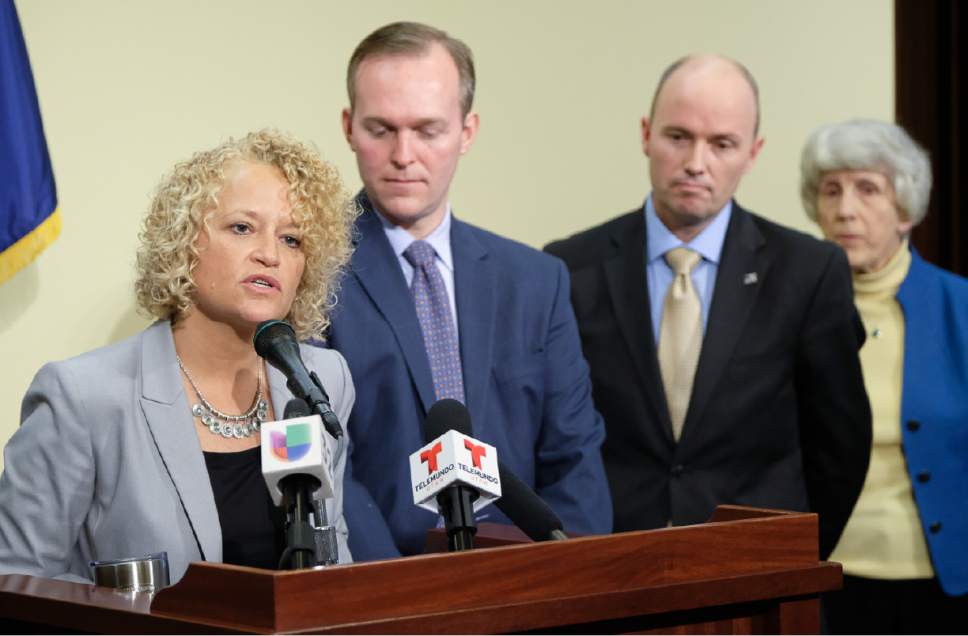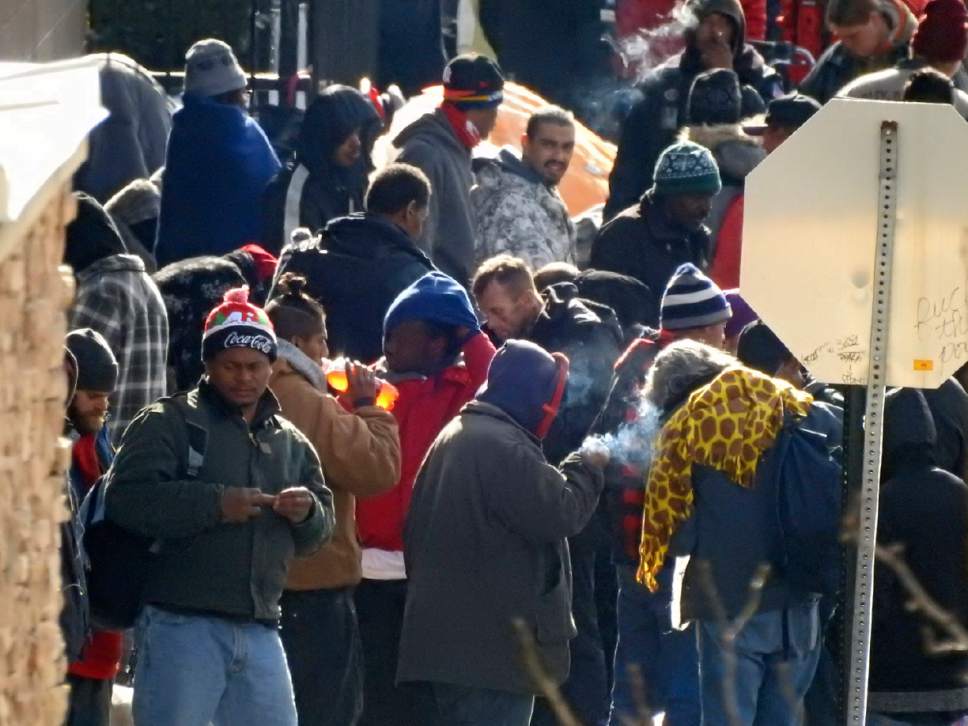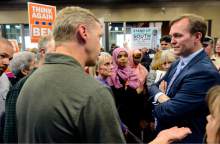This is an archived article that was published on sltrib.com in 2017, and information in the article may be outdated. It is provided only for personal research purposes and may not be reprinted.
The state may build yet another homeless shelter somewhere in Salt Lake County — though there's been no public discussion about a "drunk tank overflow" — and the kitchen feeding people living around the Rio Grande area may be pressured to close.
Those are just two takeaways from a cache of emails obtained by The Salt Lake Tribune through a records request, coming amid charged debate as Salt Lake County Mayor Ben McAdams has until Thursday to recommend a shelter site to the state's Homeless Coordinating Committee.
West Valley City, where three of his site finalists are located, has threatened to sue. South Salt Lake, which contains the other four finalists, says its small tax base will doom a site to failure.
And while McAdams' choice may quiet half his critics, other contentious issues loom in a process that has already caused abundant frustration even as it's heralded as a momentous achievement for Utah's most needy. Among those matters: the demographics that will be served by each of three new shelters and an existing family shelter in Midvale, and the need to site an additional seasonal overflow shelter in an undetermined location.
The emails were all sent either to or from McAdams since Valentine's Day, when legislative leaders first told him that the county would need to site a shelter that had previously been contemplated for Salt Lake City.
—
Will there be a second siting sequel?
In a Feb. 27 email to the committee shaping the county's homeless service model, Director of Government Relations Patrick Reimherr reassured members about a newly announced commitment to close the emergency shelter at 210 S. Rio Grande St. by July 2019.
Wrote Reimherr: "Salt Lake County and the property owner" — Shelter the Homeless Inc., a nonprofit that owns the Rio Grande and Midvale shelters and is expected to soon be granted ownership and governance of the three new shelters — "will not commit to such a decision without proof that supply is available to meet demand."
The words "will not" are bold and underlined.
The difference between the 1,100-bed capacity of the current shelter and the combined 600- to 700-bed capacity of three new ones has caused heartburn for some involved.
Reimherr told them the county was "insisting" that an additional seasonal overflow shelter "outside of Salt Lake City" be opened in time to shutter 210 S. Rio Grande St.
This shelter was included in a budget analysis prepared by the Department of Workforce Services and read by legislative leaders: $2 million in one-time costs and $350,000 ongoing for 66 seasonal beds. But it's scarcely been mentioned publicly.
Crossroads Urban Center Associate Director Bill Tibbitts wrote Feb. 25 that "[i]f the new plan includes an overflow shelter both myself and the press missed it."
McAdams responded that legislative leaders had wanted the announcement to focus on the three new resource centers but that he wouldn't support a changed direction without either a new overflow shelter or overflow availability at 210 S. Rio Grande St.
"That point is clear" with legislators, he said. "We will look for an opportunity to get that on the official record."
Former county employee Janell Fluckiger, having recently been installed as executive director of Shelter the Homeless, further responded that the nonprofit board "will not allow homeless individuals to be steamrolled in the process of closing the Rio Grande facility."
A few days earlier, Fluckiger wrote that the board — which includes area business and political leaders, including McAdams and Department of Workforce Services Executive Director Jon Pierpont — believed the state would take its turn by finding a place for the final, as-yet-unpublicized shelter.
"[S]iting shelters, especially a drunk tank overflow, is a political process that STH does not want to lead on," Fluckiger wrote.
But DWS Housing and Community Development Director Jonathan Hardy said Saturday that a dedicated overflow site may not be necessary given that the new shelters will have between 50 and 150 more beds than the original plan called for.
"If at all possible, I think we're going to try to avoid" building an overflow shelter, Hardy said, explaining that motel vouchers or an add-on wing at one of the three new shelters could help meet unforeseen demand.
Both McAdams and Shaleane Gee, Salt Lake County's director of special projects and partnerships, said their understanding is still that the state will site an overflow shelter, though likely not at one of the seven sites he's weighting for a larger, more sophisticated facility.
Said Gee: "If you don't have that somewhere in our services system, you are not being responsible."
—
What else happens on Rio Grande St.?
The current overflow shelter for Salt Lake City's homeless is across the street from the St. Vincent de Paul Kitchen, which has the primary responsibility of feeding homeless and low-income diners. On the same campus, the Weigand Homeless Resource Center provides a range of services to homeless people turned out of the emergency shelter for the day.
On March 2, Gee cautioned McAdams and county staff that they needed to be "very, very prepared for reactions when folks learn that the proposal is not just that the shelter facility there is closing but that the plan also calls for Vinny's and Weigand to close."
"People are shocked to hear this," Gee continued. "And even folks that want to see a change and the shelter go away start getting concerned when they hear that about what we are doing to the very vulnerable populations there."
That the mission might change for those two facilities has long been known. The new resource centers are expected to provide all-day services and meals, and the nearest one — at 131 E. 700 South — is 1.5 miles away from St. Vincent de Paul and Weigand.
The facilities are owned by the Catholic Diocese of Salt Lake City and operated by Catholic Community Services, which are included on the county's programming committee.
But asked Friday if she had heard any talk of closure, Danielle Stamos, spokeswoman for Catholic Community Services, replied: "Not a whisper."
"Our position is that we weren't aware of any plans and that we intend to continue serving our homeless clients right there where we are now," Stamos said.
At Monday's meeting of the Shelter the Homeless board, former Salt Lake County Mayor and president of the CCS board Peter Corroon said that between 400 and 500 area homeless people don't stay in those shelters and that CCS wants to continue to serve them.
Nobody objected.
Gee said Saturday that the county hasn't discussed closure of those facilities either internally or with the diocese.
Said McAdams on Friday: "What we're saying there is if the [210 S. Rio Grande St.] shelter closes, that begs the question about what happens to the other resources. No decisions have been made."
That statement appears to contradict not only Gee's March 2 email but also a Feb. 22 email from Fluckiger, in which she wrote that CCS and the diocese "is yet to be consulted about the repurposing of their budget, programs and property."
"This discussion needs to occur ASAP," she wrote to state and city officials.
—
Which population goes where?
In December, businessman Pat King donated $4 million toward a women's shelter to honor his mother.
On Feb. 25, the day after city and county mayors joined legislative leaders to say that the plan had changed and that Salt Lake City would site two shelters, not four, King checked back in on plans for the Geraldine E. King Women's Resource Center.
"We will proceed with the single women's shelter as planned and the intention is that it be one of the two located in Salt Lake City," Gee wrote back.
Meanwhile, Salt Lake City Mayor Jackie Biskupski told media the city shelters would house single women and a gender-segregated population, implying Salt Lake County's shelter would house single men — most frequently associated with the rampant lawbreaking on Rio Grande St.
County and state officials have said the shelter populations will be decided only after all the sites are selected. But after Wednesday's public hearing on the county's proposed sites, McAdams raised the curious possibility that the proximity of the Jordan River to five of the county's seven sites might make them suited to a population of women and children.
If women are to be in Salt Lake City, and families are already housed at a 300-bed Shelter the Homeless facility in Midvale, what did he mean? A March 8 email from McAdams raises a new possibility.
Pitching a possible shelter site, he wrote: "If this site were to go forward, I would envision it as a family site and use Midvale for single men."
The Midvale site's proximity to a rail yard led Mayor JoAnn Seghini to say last month that it was a "terrible location" for its population and to express her hope that it will move after a four-year sunset clause in legislation that overrides her city's policy and keeps it open year-round.
McAdams said state law would need to be changed if the Midvale shelter were to serve single men instead of families and that "that's not something that we've spent a lot of time looking at."
Still, he allowed: "We've thought about if that's something that we could explore,"
Gee said that homeless children are the model's top priority and that the Midvale shelter has been specifically tailored to work for families. The seven sites proposed by the county, she said, "are very specifically for single adults."
—
Did McAdams set his own deadline? (No.)
McAdams vowed to provide a "robust yet abbreviated" public process, eschewing the behind-closed-doors site selection tactics of Salt Lake City leaders and listening firsthand to more than eight hours of comment during a hastily arranged input schedule.
One of the most frequent complaints he heard: that there was no public process. Of those who acknowledged that they were, in fact, part of a public process, many said the whole thing was a sham production.
At Wednesday's hearing, Sen. Daniel Thatcher, R-West Valley, roamed the halls and stoked the flames, telling people that McAdams had written the bill and proposed the March 30 date to legislators, who couldn't have cared less about a deadline.
Emails don't support those claims.
There was robust discussion of which format to have. A town hall would be unproductive, but an open house wouldn't satisfy those who wanted to speak publicly. McAdams favored a hybrid of the two because, "It feels like we might get more qualitative input on the sites," he wrote to his team.
As to whether McAdams wrote the bill and wanted an early deadline, Gee wrote Feb. 17 that House Speaker Greg Hughes and Majority Whip Francis Gibson called on the county, as a condition of $20 million in state funding for the shelters, to open and shut its public process within a week of the Feb. 24 announcement.
McAdams has said he asked for an extension and settled on March 30.
He wrote to staff after Gee's Feb. 17 email that the process was "not ideal, but it is the timeline dictated to us by the speaker."
"I know I'm asking a lot from all of you," he wrote to his team. "We have an incredible opportunity to get significant state funding that will measurably improve the lives of thousands of people in crisis."
An email from Gee the next day indicates DWS staff, not the county, were helping Gibson draft the bill, which would ultimately deprive city officials of their power to reject the county shelter.
Twitter: @matthew_piper —
Proposed county homeless resource center sites
1820 W. Printers Row (2300 S.) • West Valley City, southwest of Glendale Golf Course, 3 acres assessed by the county at $2.5 million.
2411 S. Winston St. (1070 W.) • West Valley City, just south of Glendale Golf Course and just west of the Jordan River, 0.9 acres assessed by the county at $1.7 million.
2249 S. Winston St. (1070 W.)* • West Valley City, just south of Glendale Golf Course and just west of the Jordan River, 1.9 acres assessed by the county at $330,000.
3091 S. Main St. • South Salt Lake, occupied by Utah Trailways bus services and less than a quarter-mile from a state liquor store, 1 acre assessed by the county at $400,000.
1144 W. 3300 So. • South Salt Lake, adjacent to the Jordan River and James Madison Park and near the county's Oxbow jail, 2.6 acres assessed by the county at $3 million.
3380 S. 1000 West* • South Salt Lake, located between the Jordan River and Salt Lake County Emergency Management, 2.5 acres assessed by the county at $250,000.
3432 S. 900 West* • South Salt Lake, sandwiched between Salt Lake County Emergency Management and the Salt Lake Valley Detention Center and across the street from the county's metro jail, 1.3 acres assessed by the county at $130,000.
* Indicates a vacant lot Public meetings this week
Salt Lake County officials will host its final open house from 6 p.m. to 8 p.m. Monday at 3432 S. 900 West, for discussion about a newly proposed shelter site there and nearby at 3380 S. 1000 West. Discussion will be limited to those two locations.
The county has until Thursday to recommend one of seven sites to the state's Homeless Coordinating Committee. A county site evaluation committee will meet from 3 p.m. to 5 p.m. Tuesday at the state Capitol in Senate Room 210. Other revelations from county emails between Feb. 14 and March 15
• A Feb. 24 memorandum of understanding between Salt Lake City and Salt Lake County says final approval of the architectural design for two homeless shelters at 131 E. 700 South and 275 W. High Ave. will fall to a "Project Design Team." That would include: one county representative appointed by Mayor Ben McAdams, one city representative appointed by Mayor Jackie Biskupski, the Salt Lake City Council member whose district includes the shelter, one Department of Workforce Services representative, one Shelter the Homeless representative, Gail Miller and Palmer DePaulis. "[N]o single team member, and no individual representing the City, County or State, will have such discretion," it reads.
• On Feb. 14, Salt Lake County Director of Special Projects Shaleane Gee said that at a meeting with state, city and Shelter the Homeless leaders, it was proposed that Shelter the Homeless amend the lease of its shelter at 210 S. Rio Grande St. so that it would serve single adults only.
• Salt Lake County Real Estate Manager David Clemence shared his concern about the likelihood of environmental contamination at a proposed shelter site at 3091 S. Main St., where Utah Trailways operates a bus service. The county's due diligence is expected to be completed before its March 30 recommendation to the state, McAdams said.
• After nationally renowned homeless shelter expert Robert Marbut spoke in January at a Realtors convention, criticizing Salt Lake City for its since-scrapped model of four equal-sized shelters for distinct populations, Gee engaged him in an ongoing and friendly dialogue. Gee asked Marbut on March 1: "My request is that you consider working directly with us in partnership instead of with community groups expressly focused on shutting down service provider organizations. That chapter in our effort — getting folks to realize there is a problem in our Rio Grande area and doing [something] concrete to fix it — has concluded." Marbut has kept an eye on Salt Lake City for more than two years, Gee said Saturday, and while he favors a large single-campus model instead of a scattered-site model, he "certainly wasn't criticizing the entire services system model plan," she said.













